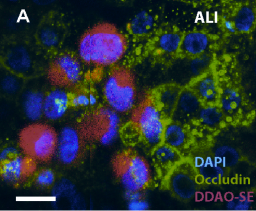Co-culture of human alveolar epithelial (hAELVi) and macrophage (THP-1) cell lines
Main Article Content
Abstract
The air-blood barrier is mainly composed of alveolar epithelial cells and macrophages. Whereas the epithelium acts as a diffusional barrier, macrophages represent an immunological barrier, in particular for larger molecules and nanoparticles.
This paper describes a new co-culture of human cell lines representing both cell types. Acquiring, culturing and maintaining primary alveolar epithelial cells presents significant logistical and technical difficulties. The recently established human alveolar epithelial lentivirus immortalized cell line, hAELVi, when grown on permeable filters, form monolayers with high functional and morphological resemblance to alveolar type I cells. To model alveolar macrophages, the human cell line THP-1 was seeded on pre-formed hAELVi monolayers.
The co-culture was characterized regarding cellular morphology, viability and barrier function. Macrophages were homogenously distributed on the epithelium and could be kept in co-culture for up to 7 days. Transmission electron microscopy showed loose contact between THP-1 and hAELVi cells. When grown at air liquid interface, both cells were covered with extracellular matrix-like structure, which was absent in THP-1 mono‑culture. In co-culture with macrophages, hAELVi cells displayed similar, sometimes even higher, trans-epithelial electrical resistance than in mono-cultures. When exposed to silver and starch NPs, hAELVi mono-cultures were more tolerant to the particles than THP-1 mono-cultures. The viability in the co-culture was similar to that of hAELVi monocultures. Transport studies with sodium fluorescein in presence/absence of EDTA proved that the co‑culture acts as functional diffusion barrier. These data demonstrate that hAELVi-/THP-1 co-cultures represent a promising model for safety and permeability studies of inhaled chemicals, drugs and nanoparticles.
Article Details
Articles are distributed under the terms of the Creative Commons Attribution 4.0 International license (http://creativecommons.org/licenses/by/4.0/), which permits unrestricted use, distribution and reproduction in any medium, provided the original work is appropriately cited (CC-BY). Copyright on any article in ALTEX is retained by the author(s).


